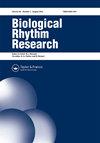Impact of photoperiods on the specific activities of immune and antioxidant enzymes in different tissues of Dybowski’s frog (Rana dybowskii)
IF 0.9
4区 生物学
Q3 BIOLOGY
引用次数: 2
Abstract
ABSTRACT Many physiological activities in amphibians show rhythmic changes to adapt to ambient light conditions. However, the effects of photoperiod variation on the immune and antioxidant status and their possible correlation with different tissues have not been reported in Dybowski’s frog, Rana dybowskii. In this study, the specific activities of immune and antioxidant enzymes in R. dybowskii under different photoperiods were evaluated. The results demonstrated that the photoperiod significantly impacted antioxidant enzymes and immune enzymes in Dybowski’s frog. In terms of antioxidant enzyme activity, catalase (CAT) and superoxide dismutase (SOD) activities in frogs at 6 L:18D and 0 L:24D were significantly higher than those at 18 L:6D and 24 L:0D, respectively. Further, the activities of these enzymes increased during the dark phase and decreased during the light phase. The malondialdehyde (MDA) content decreased significantly with the decrease in photoperiod time. Lysozyme (LZM) activity in serum and the liver decreased with a prolonged photoperiod. LZM activity in the dark cycle was higher, but the peak activity in skin occurred at noon. Thus, long-term light exposure may cause oxidative stress in Dybowski’s frog. Accordingly, a 6 L:18D photoperiod may be suitable for optimum physiological functions of this species.光周期对迪氏蛙不同组织免疫和抗氧化酶比活性的影响
摘要两栖动物的许多生理活动都表现出节律性变化,以适应环境光照条件。然而,在戴博夫斯基蛙中,光周期变化对免疫和抗氧化状态的影响及其与不同组织的可能相关性尚未报道。在本研究中,评估了在不同光周期下,戴博夫斯基的免疫酶和抗氧化酶的特异性活性。结果表明,光周期对Dybowski蛙体内的抗氧化酶和免疫酶有显著影响。在抗氧化酶活性方面,6L:18D和0L:24D时青蛙的过氧化氢酶(CAT)和超氧化物歧化酶(SOD)活性分别显著高于18L:6D和24L:0D时。此外,这些酶的活性在暗相期间增加,而在亮相期间降低。丙二醛(MDA)含量随光周期时间的缩短而显著下降。血清和肝脏中的溶菌酶(LZM)活性随着光周期的延长而降低。LZM活性在暗周期较高,但皮肤活性峰值出现在中午。因此,长期光照可能会导致戴博夫斯基蛙的氧化应激。因此,6L:18D的光周期可能适合于该物种的最佳生理功能。
本文章由计算机程序翻译,如有差异,请以英文原文为准。
求助全文
约1分钟内获得全文
求助全文
来源期刊

Biological Rhythm Research
生物-生理学
CiteScore
3.00
自引率
9.10%
发文量
34
审稿时长
6-12 weeks
期刊介绍:
The principal aim of Biological Rhythm Research is to cover any aspect of research into the broad topic of biological rhythms. The area covered can range from studies at the genetic or molecular level to those of behavioural or clinical topics. It can also include ultradian, circadian, infradian or annual rhythms. In this way, the Editorial Board tries to stimulate interdisciplinary rhythm research. Such an aim reflects not only the similarity of the methods used in different fields of chronobiology, but also the fact that many influences that exert controlling or masking effects are common. Amongst the controlling factors, attention is paid to the effects of climate change on living organisms. So, papers dealing with biometeorological aspects can also be submitted.
The Journal publishes original scientific research papers, review papers, short notes on research in progress, book reviews and summaries of activities, symposia and congresses of national and international organizations dealing with rhythmic phenomena.
 求助内容:
求助内容: 应助结果提醒方式:
应助结果提醒方式:


